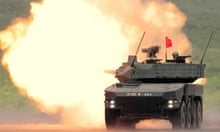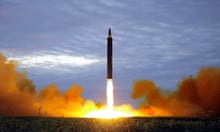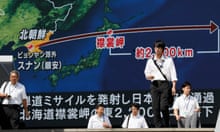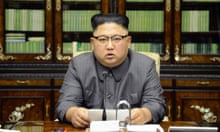Donald Trump and Shinzo Abe have vowed to increase pressure on North Korea after the regime launched a missile over Japan on Tuesday morning.
The Japanese prime minister denounced the launch as an “unprecedented and grave threat” to the country’s security. In a 40-minute phone call with the US president they agreed to call for an emergency meeting of the UN security council to discuss the situation.
Officials in South Korea said the missile may have flown further than any other tested by North Korea. The test, one of the most provocative ever from the reclusive state, sent a clear message to Washington just weeks after Kim Jong-un threatened to target the US Pacific territory of Guam with similar intermediate-range missiles.
It also demonstrated the regime’s willingness to raise the diplomatic stakes by sending a missile directly over Japanese territory. Pyongyang has tested more powerful intercontinental ballistic missiles (ICBM) this year, but Tuesday’s launch followed a much flatter trajectory than those tests.
Trump said the US was “100% with Japan” and repeated his strong commitment to the defence of Japan, Abe said shortly after the call.
“The outrageous act of firing a missile over our country is an unprecedented, serious and grave threat and greatly damages regional peace and security,” Abe told reporters in Tokyo, adding that his government had protested to Pyongyang via the Japanese embassy in Beijing.
The missile was the third fired by North Korea to have passed over Japanese territory. The first was in 1998 and the second in 2009, although Pyongyang claims they were satellites.
Abe said Japan would “strongly call for increased pressure on North Korea in cooperation with the international community” via the security council.
The missile, thought to be a new intermediate-range Hwasong-12, flew over Hokkaido and landed in the Pacific about 733 miles (1,180km) east of the northern Japanese island, South Korean and Japanese officials said.
The Hwasong-12 is the same type of missile North Korea recently threatened to launch towards Guam.
China called for restraint and warned that the situation on the Korean peninsular had reached “a tipping point approaching a crisis”.
Foreign ministry spokeswoman Hua Chunying told a daily press briefing in Beijing: “Think hard about it, who do you think should take the blame, if China is urging all parties to calm down while one party holds constant military exercises … and the other is constantly launching missiles?”
Japan’s J-Alert warning system advised people across a large area of northern Japan to seek shelter. Japan’s self-defence forces did not attempt to shoot down the missile and there were no reports of damage from falling debris.
The public broadcaster NHK said the missile had been launched from a site near the North Korean capital, Pyongyang and passed over a sparsely populated area of Hokkaido just after 6am local time (10pm Monday British summer time). It broke into three parts and landed in the sea.
Seoul’s joint chiefs of staff (JCS) said the missile travelled about 2,700km and reached a maximum height of 550km.
The JCS said it was analysing the launch with the US and that South Korea’s military had strengthened its monitoring and preparation in case of further actions from North Korea.
Abe said his government was trying to establish the details of the launch and was doing everything possible to ensure the safety of the Japanese people.
Tuesday’s launch may have been a show of defiance towards military drills involving US and South Korean troops as well as a smaller number of personnel from other countries.
The drills have coincided with a dramatic rise in tensions on the Korean peninsula after North Korea’s test launch of two ICBMs and its threat to target seas off the coast of the Guam.
Seoul and Washington say their drills are an opportunity for the allies to improve their defensive capabilities but Pyongyang routinely denounces them as a dress rehearsal for war against North Korea.
On Tuesday North Korea’s ambassador to the UN said the joint exercises were driving the Korean peninsula towards “an extreme level of explosion”.
“Now that the US has openly declared its hostile intention towards the Democratic People’s Republic of Korea, by waging aggressive joint military exercises despite repeated warnings … my country has every reason to respond with tough counter-measures as an exercise of its right to self defence,” Han Tae Song told the UN conference on disarmament, which is taking place in Geneva.
At the UN conference, multiple envoys, including those from the US, European Union, Japan and Australia took the floor to blast North Korea. “My hope is that North Korea ends this provocative behaviour,” US ambassador Robert Wood said.
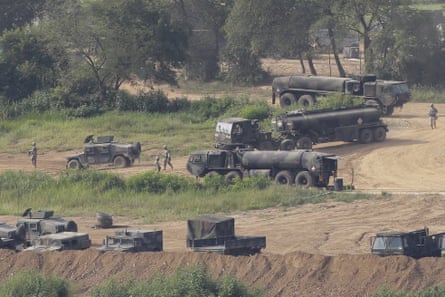
The latest launch came three days after the North fired what were assessed as three short-range ballistic missiles into the sea and a month after its second test flight of an ICBM that analysts say could theoretically reach the US mainland.
Tuesday’s missile landed nowhere near Guam, which is about 2,500km south of Tokyo, but it covered enough distance to suggest that North Korea could follow up on its threat to the US territory.
South Korea said it was launched from Sunan, the location of Pyongyang’s international airport, raising the possibility that a runway was used as the launchpad.
Several towns in Japan have held evacuation drills this year in anticipation of a North Korean attack and there has been a steep rise in sales of individual nuclear shelters.
After North Korea threatened to fire a volley of missiles towards Guam earlier this month, Japan deployed Patriot missile defence systems in areas along the missiles’ anticipated route. Japan also has an Aegis destroyer stationed in the Sea of Japan.
North Korea first fired a missile over Japanese territory in 1998, triggering widespread condemnation and attempts by Japan’s government to improve its missile defence systems.
Japan has in the past vowed to shoot down North Korean missiles or rockets that threaten to hit its territory. In 2009 a North Korean rocket passed over Japanese territory without incident, leading to an immediate denunciation by Japan.
At the time North Korea said it was launching a telecommunications satellite but Washington, Seoul and Tokyo believed Pyongyang was testing an ICBM.
Wang Zhen in Beijing and agencies contributed to this report
